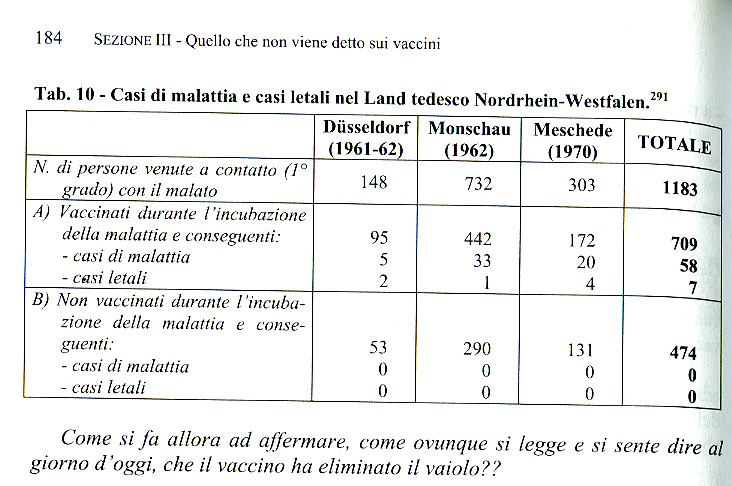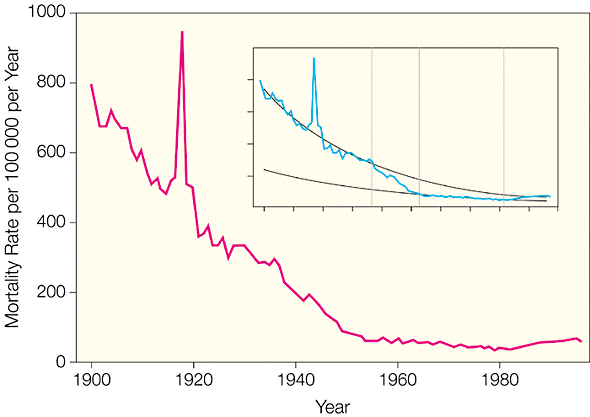 Most probably everybody knows that smallpox (a serious infectious disease with a high number of fatalities in the past) was declared as eradicated from the face of Earth during May 1980 by WHO (World Health Organization). Tows Maow Maalin, a Somali cook, was the last recorded case of someone infected by such a plague on 26 October 1977. Vaccination campaigns were suspended worldwide between the '70 and the '80. In Italy they were suspended in 1977 and abolished in 1981.1
Most probably everybody knows that smallpox (a serious infectious disease with a high number of fatalities in the past) was declared as eradicated from the face of Earth during May 1980 by WHO (World Health Organization). Tows Maow Maalin, a Somali cook, was the last recorded case of someone infected by such a plague on 26 October 1977. Vaccination campaigns were suspended worldwide between the '70 and the '80. In Italy they were suspended in 1977 and abolished in 1981.1
Although smallpox is by now a completely vanquished disease, examining the facts leading to its eradication could assist in putting in the right perspective many claims about vaccinations and their usefulness.
A diffused commonplace claims in fact that the vanquishing of such a disease was due to vaccination campaigns but it's impossible to find any scientific study supporting what in reality should be regarded as a mere hypothesis. On the other hand, by analysing all data we could find on the matter, this present article aims to demonstrate how much this diffused belief could be false and groundless. 2
The idea of a vaccine for smallpox is due to Edward Jenner, who, according to his observations, found that those who fell ill with cowpox developed immunity for smallpox. His experiment, carried out in 1796, consisted in obtaining purulent material from the bumps of a cow that had contracted cowpox and injecting it into patients in order to immunise them. The name "vaccine" (from “vacca”, Latin for cow) came from the fact that he used cows in order to obtain the material used for the immunisation.
The first person to receive this treatment was James Pipps, an eight years old child. The child contracted cowpox and after a few weeks was exposed to smallpox without contracting the disease. Jenner therefore deduced that the practice vaccination had granted immunity for his patient. Jenner administered the same treatment to his own son too: the boys died both of tuberculosis later on at a young age (around 20).
Jenner’s assumption, never scientifically verified by anyone else, did spread quickly around the world because there was no other known cure for the disease. A few years later a mass vaccination program was put in place as a measure attempting to fight the epidemics caused by the disease.
= English data =
England introduced the smallpox vaccine in 1798 and sanctioned it as mandatory in 1853 by the "Compulsory Vaccination Act" that was not well received from the population and therefore was again reinforced by a further law in 1867. The data in our possession would confirm that, in spite of all the enforcing by rulers, in the years there were no meaningful variations in mortality rate due to smallpox.3
- during those years three epidemics of smallpox occurred: in 1857-59, in 1863-65 and the most serious of them all during 1871-72;
- the vaccination rate among the whole population in 1872 was indeed up to 86% and within that year the mortality rates for smallpox reached their top peak;
- by the next few years, during which the vaccination rates went on a reducing trend down to 61% in 1898, the very minimum of mortality for this disease was recorded;
- up to 1902 vaccination rate increased again to 71,8% and soon after a new peak of mortality statistic curve was recorded.
We also note that during those times when England was vaccinated to the highest rates not only the country endured the hardest attacks of smallpox but the majority of cases were recorded among the vaccinated people themselves.
Following are some meaningful official statistics from late 19th to early 20th centuries:4
- Statistics from Highgate Smallpox Hospital show that in 1871 91% of the cases were related to vaccinated patients and that in 1881, within a total of 491 cases, 470, that is approximately 96%, had been previously vaccinated.
- On 23th February 1884 "The Lancet" supplies the following data regarding the smallpox epidemic in Sunderland: out of 100 cases, 96 were among vaccinated patients and during the one in Browley out of 43 cases 43 of them were vaccinated.
- Sheffield, a city in which hygiene measures were poor, in 1887-1888 was theatre of a virulent epidemic. Out of 7066 infected cases, 5891 were vaccinated, that makes the 83.4% of the total cases.
- In Warrington during 1892-1893, out of 647 cases 601, as to say 89.2%, were vaccinated persons. Also in Birmingham during 1892-1893, 2616 cases out of 2945 (88.8%) were involving patients recorded as vaccinated and in Willenhall, in 1894, 739 cases out of 828 (89.3%) were vaccinated.
- In London, in 1901-1902, out of nearly 10,000 cases, 7,000 involved vaccinated persons.
The data from London, the most vaccinated city in the kingdom, it's useful to compare records of a 5 years period (1819-1823) preceding the enforcement of mandatory vaccination, with those of another five years (1869-1873) when compulsion was continually enforced since 20 years earlier.5
In the first five years when the vaccination was not yet mandatory and the number of the vaccinated persons probably did not exceed 10% of the entire population, in London the number of deaths caused by smallpox was on average of 292 per year, while during the second five years of considered timeframe, when the vaccinations had been rigorously practiced for twenty years and the number of the vaccinated person constituted 95% of the whole population, the average number of deaths was 679 per year, showing a substantial stability in mortality rate, holding also in account the rate of demographic increment.6 7
= German data =
The most complete data in Germany were collected in the studies of Dr. Gerhard Buchwald, German physician and physicist and senior physician for 20 years retiring in 1990, consisting of more than 3000 publications on the problems related to vaccinations.8
From Buchwald’s studies it emerges that it is most likely that the anti-smallpox vaccination served the purpose, as it appeared also evident from English sources, of spreading the disease and increase mortality. German population, from 1947 to 1974, recorded an increase of infected as well as of lethal cases in those who had been vaccinated and in particular in those who had from one to three recalls of the vaccine.
In spite of these result the practice of smallpox vaccination was advertised and outlined as sure and effective. Dr. Buchwald collected thousands of cases of persons badly affected from vaccinations, after the dangerousness of such a practice already had been evidenced by Dr. Kittel, who stated that up to ' 67 in Western Germany 3297 children received serious damages to hearing, and, of these, 71 remained deft after been vaccinated against smallpox. Children who repeated the vaccine various times were found having white globules with chromosomic aberrations. Moreover Miller reports nine patients who developed multiple sclerosis after the first or second smallpox vaccination.910
Dr. Buchwald instead remarks that among the 277,000 not vaccinated inhabitants of the German city of Meschede there was not even a single case, which is strikingly different to what happened in the same year 1970 to the vaccinated population.
Dr. Buchwald points out particularly at what happened during the decade 1961-1970 when, because of some alerts of smallpox, those who came to contact with the sick ones were divided in two groups: a group was vaccinated during the disease incubation period and the other group was not vaccinated at all.
Well, while within the vaccinated group were occurring cases of infection and also lethal cases, no one within the not vaccinated group went ill or died.

= Indian data =
According to a report in August 1967, up to that time 537 million doses of smallpox vaccine had been inoculated on a population of 511 million.11 Although the number of carried out vaccinations is impressive indeed, the most serious smallpox epidemic, with the possible exclusion of the 1963 one, hit the country in 1967 when 60.000 cases were assessed. In order to justify such a failure, problems due to bad organization and a poor kind of vaccine have been reported in addition to bad information and religious opposition to the practice of vaccination. But from issues of the WHO review "Weekly Epidemiological Record" at the time of the 1967 campaign, is apparent that WHO never stated that mass smallpox vaccination was to be considered the key to the success they enjoyed from that time onwards. Quite opposite, even WHO realised that during periods in which they considerably increased the number of vaccinations also the smallpox infections were on the increase. Before the smallpox extirpation plan, India already had tried to extirpate the disease through numerous mass vaccinations campaigns actuated in 1952, 1957, 1958, 1963, 1967, 1973 and 1974.
After these mass campaigns there was always an increase of assessed smallpox cases, as we have documented to be happening in England and Germany.
Because of this failure WHO decided that the so-called "modified program” was to be enforced. With "modified" they meant withdrawal of uncontrolled mass campaigns giving more relevance to punctual vigilance, strict isolation of the sick patients, quarantine, disinfection of all objects in contact with the sick, etc. With the introduction of these safeguarding measures was possible to have smallpox disappearing from the face of Earth in a short time and only because of these measures the WHO program could be the success we know of today.
= I dati italiani =
We do not have records until 1892, year in which mandatory vaccination was made law for all 2 years old children. We know thought that at the end of that century death by smallpox hit in the same proportion both vaccinated and not vaccinated population. Moreover the mass vaccination campaigns did nothing to avoid the epidemics of 1901-05, 1910-12 and 1918-21.11

= WHO Admission =
In an editorial of a German scientific review, its director, Prof. Lang, stated that without a proper vaccination procedure any population would be exposed to smallpox epidemics but, although the above mentioned data are more than sufficient in order to be opposing that point of view, it is interesting to know that in the very WHO official review in "Weekly Epidemiological Record" states: "Experience teaches that a very serious an infectious disease like smallpox has been made to disappear through measures as quarantine and isolation".
As a confirmation of the above mentioned remark, the Director’s relation to the Executive Committee General Office about 1977 WHO program to fight smallpox states: “During the decennial fight towards elimination of smallpox has emerged that the smallpox can be spread also in a completely vaccinated population. Consequently another strategy has been adopted: mass vaccination has been replaced with monitoring and aimed treatment of the diseased".12 Moreover, in the pamphlet "Travels & Health" published by WHO states:” WHO considers the smallpox eradicated now for more than ten years. The smallpox vaccination does not have therefore any justification and indeed it can have negative effects on the person who has it administered and on those in close contact with him/her".
= Conclusioni =
Infectious pathologies and smallpox in particular, have been reduced by improved living conditions and not by mass vaccinations. Since in the same period in which this it has been happening also vaccination have been introduced, we had been made to believe that the latter have had an important role in the vanquishing of infectious diseases, but it is possible to verify from on hand data that the decrease in mortality caused from such was an on-going trend already several years before the starting of mass vaccination campaigns. Partisan information of the opposite view is supported by graphs but tends to cut the parts of them that are preceding the beginning of mass vaccinations, and the evidence showing exactly the regression of the main infectious diseases as on-going already many years before because of improvements in the hygienic-alimentary conditions.
The diagram below shows the trend in mortality within American population, beginning from 1900: a drastic decrease is evidenced both for overall mortality as well as for mortality due the 11 more common infectious diseases, without any aimed sanitary intervention. In both cases there is a continuous decrease already beginning from 1910 and therefore some time before the introduction of mass vaccinations and also before the introduction of antibiotics.
From the same diagram it is possible to notice that the first mass vaccinations against the main infectious diseases were introduced in the '50 and their mortality rate was already drastically reduced.13

On that matter an editorial of a paediatrics review stated that "In history, the greater lessening of virulence and mortalities caused from infectious diseases has not been an achievement of modern antibiotics or vaccines, but of the introduction of clean water and of sewage systems".14
What it is possible to draw from the admission of the same by WHO is that now that the economic interest justifying the use of smallpox vaccine does not exists anymore, can be freely found, in black on white, that it is an unethical vaccine because is dangerous for the treated patients and for who is close to them while before, when the vaccine was still used, all this did not only come into writing, but was not either thinkable or permissible to be said.
Professor the Koch, during a broadcasting in 1922 from Stuttgart, said: "Smallpox vaccine has had remarkable undesired effects and today we can be only sorry for the fact that its mandatory practice has been abolished too late. With a little more courage we could have acted in such a direction long earlier".15
On the other hand, how difficult it could be for a doctor to go against common today’s views on vaccines can be guessed from a book on paediatric infectious diseases written by a German author in1993: "Every doctor and also every medicine student that is of a different opinion on decisive issues about vaccines must be aware that, in the eyes of his colleagues, if he is ready to state his own opinions in public will be a drop-out that is defaming Science".16
Such kinds of statements are of any help to scientific progress?
Is the presumption of knowing already everything that has to be known on a given argument, believing to possess the absolute truth and trying to block every different opinion using intimidation, a scientific-minded attitude?
The answer is surely a no.
But unfortunately in similar cases science engages conflicts with commercial interests of large industrial corporations, the ones controlling also the way information is spread through PR professionals able to skilfully manipulate public opinion in order to serve the interests of their customer - in this case the big pharmaceutical industries. That is why it becomes necessary to learn to recover information in alternative ways, actively searching for them instead of being satisfied with what we are fed with, in order to be in the position of making informed choices not led by fear or ignorance.
Translation by Pike Bishop for Il Portico Dipinto.
- 1. http://www.epicentro.iss.it/problemi/vaiolo/vaiolo.asp
- 2. The main reference for this article is the corresponding section of the book "Le vaccinazioni pediatriche" di Roberto Gava, edizioni Salus 2008, pagine 179-190.
- 3. Bennati C., Ambrosi F., Rosa C. - "Vaccinazioni tra scienza e propaganda. Elementi critici di riflessione". Edizioni il leone verde, Torino, 2006, pag. 47.
- 4. Fernand Delarue, "L'intossicazione da vaccino", edizioni Feltrinelli, pag. 38.
- 5. "Revue de pathologie générale et de chimique", n°694, gennaio 1958. L. Cl. Vincent, Journées de pathologie comparée de langue francaise.
- 6. Fernand Delarue, "L'intossicazione da vaccino", edizioni Feltrinelli, pag. 41.
- 7. http://en.wikipedia.org/wiki/Demography_of_London#Population_change
- 8. Buchwald G. "Vaccinazioni, il business della paura. Quello che ogni genitore dovrebbe sapere". Ed. Civis, Massagnago (Lugano).
- 9. Sezione "Vaiolo" della pagina http://www.vitanaturale.it/vaccini/evitare_vaccinazioni.php
- 10. "HEARING DISORDER FOLLOWING SMALLPOX VACCINATION": http://www.ncbi.nlm.nih.gov/pubmed/14336723
- 11. a. b. Roberto Gava, "Le vaccinazioni pediatriche", edizioni Salus 2008, pag. 185.
- 12. Buchwald G. "Vaccinazioni, il business della paura. Quello che ogni genitore dovrebbe sapere". CIVIS, Massagno (Lugano), 2000, pag. 159.
- 13. "Trends in infectious disease mortality in the United States during the 20th century", Armstrong GL, Conn LA, Pinner RW: http://www.ncbi.nlm.nih.gov/pubmed/9892452
- 14. Editorial. "Zinc, diarrhea and pneumonia". J. Pediatr. 135 (6): 66; 1999. : http://www.ncbi.nlm.nih.gov/pubmed/10586170
- 15. Schhad Urs B. "Padiatrische Infektiologie". Edizioni Hasn Marseille Gmbh, Monaco, 1993.
- 16. Buchwald G. "Vaccinazioni, il business della paura. Quello che ogni genitore dovrebbe sapere". CIVIS, Massagno (Lugano), 2000, pag. 159.
- Dusty's blog
- Login per inviare commenti
- Italiano
- Versione stampabile
- Send by email

![[Most Recent Quotes from www.kitco.com]](http://www.kitconet.com/charts/metals/gold/t24_au_en_euoz_2.gif)
![[Most Recent Quotes from www.kitco.com]](http://www.kitconet.com/charts/metals/silver/t24_ag_en_euoz_2.gif)
![[Most Recent Exchange Rate from www.kitco.com]](http://www.weblinks247.com/exrate/exr24_eu_en_2.gif)






The Proof that Vaccines Have
The Proof that Vaccines Have not Saved Us